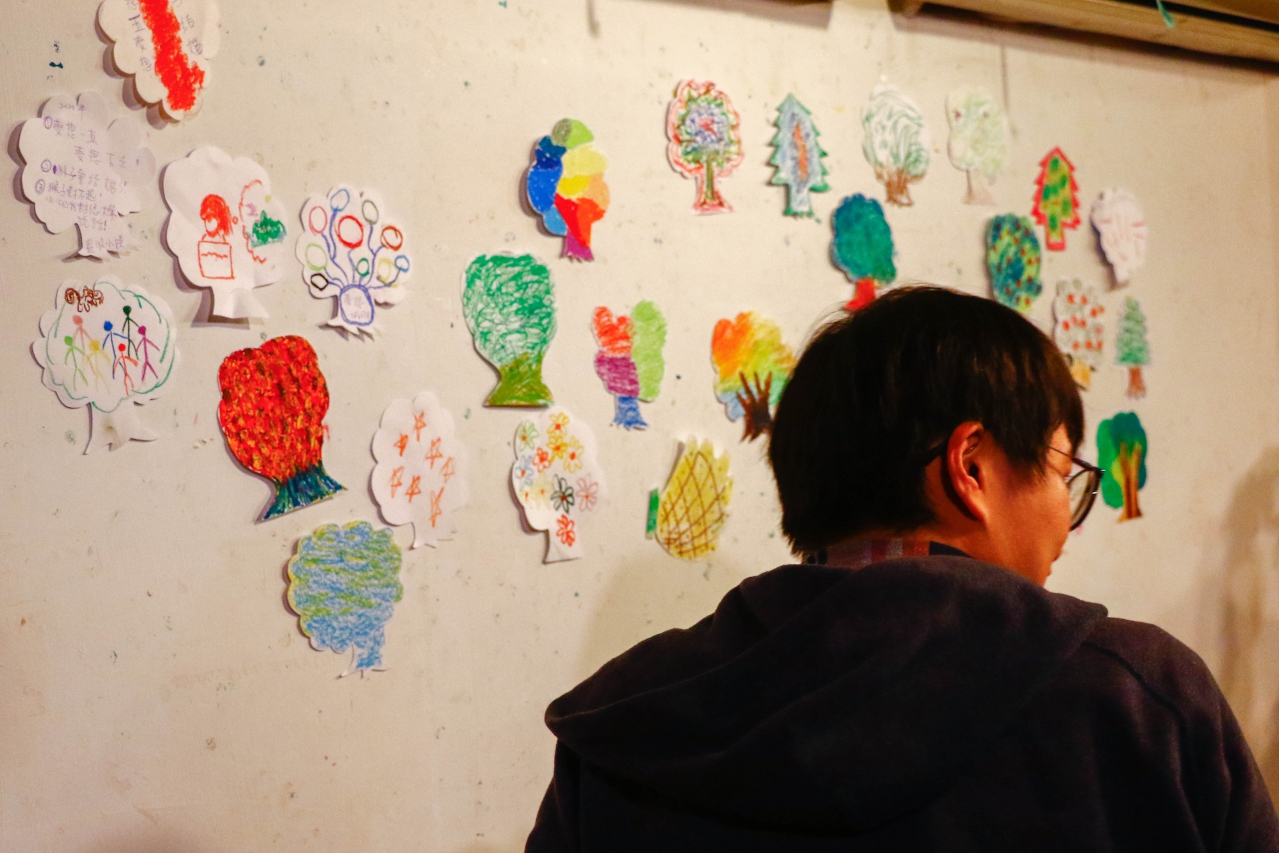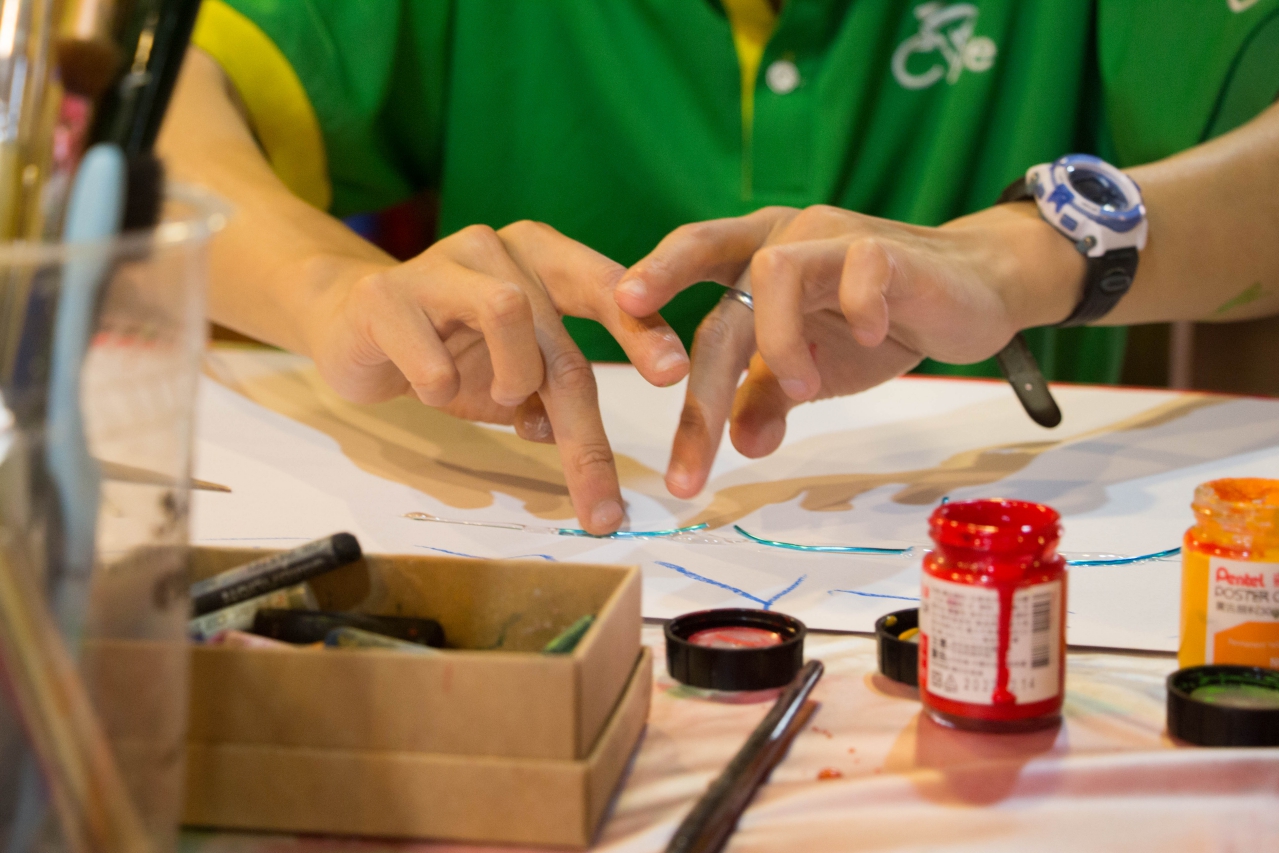大三那年,很自然地知道自己必須找校外實習的機會,以讓未來求職的路途順遂一些。外界對於中文系的想像,無非就是教職、公職、出版社;而帶有反叛精神的我,則千方百計想要撕下這一標籤,淨是找上述三者之外的單位。
坦白說,台灣夢想城鄉營造協會(簡稱夢想城鄉)一開始壓根不在考慮範圍內,原因無他,僅是很現實勢利地認為,在這樣一個社區型的、知名度不高的非營利組織實習一年,很難想像能為履歷增色多少。但或許是對於貧窮議題感到好奇,或許是招募貼文中寫著如果你是「懷疑那些理所當然的價值秩序,希望能動手創造自己想要的生活」的人,最終我還是決定拋卻現實考量,將履歷整理好後寄出,並幸運地獲得實習的機會。
在正式開始實習之前,我對於創作課的想像,除了招募貼文上寫的「透過創作,可以發現每一個人獨特的樣貌,生命的每一段片刻,在創作中連結成一片時光。」其餘大概就是「每個週五下午,我要去陪一群無家者畫畫。」
 每一次的創作課,參與者們會將自己的作品貼在牆上和大家分享。圖/邱珞晽提供
每一次的創作課,參與者們會將自己的作品貼在牆上和大家分享。圖/邱珞晽提供
夢想城鄉的據點位於萬華的剝皮寮歷史街區,廣州街161號。推開舊式的木頭推拉門,屋內中央有著同樣舊式的木製鏤空階梯。夢想城鄉的創作課,就在沿階而上的二樓空間。我參與的第一堂創作課,印象最深刻的是一場共同創作。一顆大大的瑜珈球從天花板垂掛下來,懸在半空中;帶領課程的宜潔、亮亮、小米發給實習生與學員們一人一個紙杯,裡面裝了不同的與水混合的顏料。大家圍著那顆大球,將手中的顏料從球的頂部往下倒。
 液態的顏料往下流淌,各色相遇相融在大球上形成另一種色彩。圖/邱珞晽提供
液態的顏料往下流淌,各色相遇相融在大球上形成另一種色彩。圖/邱珞晽提供
液態的顏料往下流淌,各色相遇相融成另一種色彩;而未能附著於球體的那些顏料,則滴在鋪於地上的霧面塑膠布上。看似新奇有趣,但當時的狀況其實頗為混亂。有個大哥執意要拿水彩筆將球上的顏料均勻混合,讓原本多彩的顏料逐漸一概變成灰濁的咖啡色。雖然有多個工作人員耐心地跟他說明,他似乎仍不打算停手。那時的我在心裡忍不住皺眉頭,但又告訴自己應該給予這些「與我經歷極為不同的人」多一點的包容。
如今回想起來,當時自己多少是帶著憐憫的眼光在看待他們。
創作課的模式,是由一位實習生或工作者陪伴一到二位學員,一開始先進行較簡單的、5到10分鐘左右的創作,或是做一些活動肢體的簡單團康當作暖身,再進入當日的主題,這一階段通常會有30到40分鐘。先完成作品的人,會將作品先行貼到白色牆面上。待大家都完成後,再輪流上台與其他人分享自己的創作。在進行暖身創作時,經常會搭配具象的物品,有時是從雜誌與網路圖庫找到的插圖,有時則是亮亮蒐集的扭蛋玩偶。這些東西會在課前就擺滿一桌,創作課開始後就邀請大家向前挑選,主題可能是「與自己最相像的動物」,也可能是「最有感覺的畫面」等。我很喜歡這樣的做法,讓大家在正式進入創作之前,可以慢慢打開自己的想像力與感知能力。
為了盡可能讓每個人都能自在順利地進行創作,除了暖身之外,在設定的主題與提供的媒材方面,也都可以看見工作者們的用心。
以創作主題來說,通常都是發揮空間很大的題目。具體的如《河流》、抽象的如《心願》,都是絕大多數的人會經歷過的,而不會出現像是《出國旅遊》這類,難以讓每個人都有所共鳴的主題。但倘若對於當天的主題真的沒有興趣,或是有更想創作的題材,也完全有彈性可以自由進行。
 創作課的媒材多元,每個人都能夠依據自己的個性選用喜歡的材料來表達。圖/邱珞晽提供
創作課的媒材多元,每個人都能夠依據自己的個性選用喜歡的材料來表達。圖/邱珞晽提供
 創作課的課程統籌亮亮蒐集來的各種扭蛋玩偶,也成為創作課上暖身用的靈感來源。圖/邱珞晽提供
創作課的課程統籌亮亮蒐集來的各種扭蛋玩偶,也成為創作課上暖身用的靈感來源。圖/邱珞晽提供
而在媒材方面,除了粉蠟筆之外,也有色鉛筆、乾燥花、毛根、亮片、輕黏土、廣告顏料、色紙等。當媒材多樣性越來越高後,可以看出每個人喜歡用的媒材都不一樣,愛乾淨的惠姐較喜歡用不沾手的色鉛筆;大劉則看當天心情,通常喜歡用多種媒材合力進行;華哥則因為視力不好,偏好用色彩明顯、好抓握的粉蠟筆。
不少單位的實習都是以學期、寒暑假為單位,就我所知,像是夢想城鄉這樣為期一年的實是少數。但在幾次創作課後,我好像可以理解為什麼是一年?信任的建立,是雙方慢慢將自己的心交出去的過程。尚且不論像我這樣人生大抵平順的人,要給出信任需要多少時間;來到夢想城鄉的大哥大姐們,在顛簸的生命旅途上大多歷經人情冷暖,要與這樣的他們達到一定程度的互信,勢必更困難吧?
或許只能套句俗濫卻精確的話:真心要用時間去證明。
 創作課參與者的作品,使用適合自身個性、習慣的方式完成一次次的創作。圖/邱珞晽提供
創作課參與者的作品,使用適合自身個性、習慣的方式完成一次次的創作。圖/邱珞晽提供
透過作品進行溝通,是一種新鮮有趣的體驗。我喜歡指著大哥或大姐畫的圖,問他們這是什麼那是什麼;喜歡他們與我分享的神情;更喜歡感受他們日漸對我堆疊起來的信任。從寡言到健談,從一問一答到來回對話,原本的界線之所以能夠慢慢消融,我之所以漸漸能以近似於我與阿公阿嬤相處的方式與他們互動,除了深深感謝他們願意鼓起勇氣,也想談談我的心路歷程。
在夢想城鄉實習的這一年,我學到最多的應該是「以經驗回應經驗」,還有「共感」的能力。剛開始,我會不確定自己在跟大哥大姊分享生活時,如果我跟他們分享的,是他們未曾擁有(或無法擁有)的體驗,會不會讓他們因此感到失落甚或自卑?因為這層擔心,起初我都只是就他們提到的內容再去探問,但這樣的對話到底無法深入,也很容易就落入無話可說的窘境。
為了解決這個問題,我開始嘗試著多說一點關於自己的生活,驚訝地發現其實我與他們的差異沒有我以為的大。當我說我去哪裡玩的時候,好幾個大哥大姐也有不少出遊經驗。他們會用有限的資源去發掘樂趣,例如華哥跟惠姐,會搭公車到遠處走走;彼得潘會搭火車去外縣市抓寶可夢,他們並不因為經濟較不寬裕就失去能動性。
不僅是談話的內容,在情緒方面也經過反覆地調適。
起初我在與學員互動時,總是會自認身分是實習生、是助人的角色,因此會期待自己的心情必須平穩、應對必須成熟,甚至不可以對學員們產生負面情緒。但當時的我深受憂鬱症所苦,狀況時好時壞,達不到自己的標準而感到失望透頂是家常便飯。每當被情緒漩渦捲入時,總會因為不願面對令我厭惡的自己而失去一切氣力。連移動到剝皮寮都沒有辦法時,我要向大家坦承嗎?還是要為了掩蓋罹患精神疾患的事實而勉強自己?即使憎惡精神疾病往往被汙名化,而期許自己不要避諱談論,而可以從自身做起將標籤撕下。但同時也清楚知道,一旦說出口,怕是周遭的人看待我的眼光就會無法復返地變得不同。
掙扎幾次後,我還是鼓起勇氣向宜潔說明自己的情況。雖然已不記得詳細的對話內容,但我知道後來的我,可以很輕易地在夢想城鄉分享生病的經歷與感受,談論憂鬱症可以跟說起自己得了感冒、腸胃炎一樣自然。
如今想起,我過去的這份擔憂,和一些大哥大姐們或許是相同的吧?就算自身的處境再糟,卻因為被同情或許會顯得更加不堪,故選擇不向外求助。然而,同理是困難的,沒有經歷過類似的情況,有時說同理顯得沒有說服力。但夢想城鄉的大家採取一種剛剛好的姿態:理解與包容,並且將關心的力道拿捏得恰如其分。
 夢想城鄉創作課的休息空間。圖/邱珞晽提供
夢想城鄉創作課的休息空間。圖/邱珞晽提供
我在孩提時期是熱愛畫圖的。會飛又會潛水的車、可以打敗敵人的機械食人花在日曆紙、單面考卷上被發明,畫著畫著就是一個下午。但隨著年齡增長,開始會在意他人眼光,會考慮世俗對於美、對於好的判準,於是那些從前看起來很酷的圖畫,突然就變得幼稚且拙劣了。因此剛開始在創作課要畫圖時,過去那些自我否認的感受不斷被召喚,一直忍不住擔心自己畫得不「好」,甚至會因為這份擔憂,面臨無法下筆的困境。
要將過去的負面經驗消除,最好的方式該是創造好的經驗來覆蓋。在夢想城鄉的創作課上,好經驗出乎我意料地快速累積。我參與幾次課堂後就知道在這個地方,創作單純是一種自我表達,以及與他人對話的媒介,無關美醜對錯,也沒有人會任意評價他人的作品。
***
其中一個例子,是有段時間我經常陪伴的一位伯伯,大家都叫他雄哥。
雄哥花白的頭髮理得很短,總是戴著棒球帽。他上課幾乎從未遲到,每次我爬上二樓,都會看見他已經坐在位子上,而後我就會大聲地向他問好。
「你好你好。」雄哥總是這樣說,時常會順帶拿起一個塑膠袋,從中撈出幾包餅乾:「這個餅乾給你吃。」
他並不是特別健談的人,但變得熟稔之後,每次我主動開啟話題,雄哥都有所回應。進行創作時他通常都很投入,內容大多與他自己的生命經驗相關。印象中他曾畫過一幅作品,畫面裡以橘紅色的粉蠟筆勾勒出一間廟宇,廟宇後有山、旁邊有人。
「這是關渡宮,那邊附近有一條步道,我會去那邊散步,可以看到很多鳥。」
「你都怎麼去啊?好遠耶。」我問道。
「搭公車。」雄哥簡短地回答,又說:「你有空也可以去。」
雄哥是個樂於分享的人,農曆年前的一次創作課,閒聊時他與我聊到,說過年時會有人請吃免費的年夜飯,還可以領到紅包。我猜雄哥說的是「刈包吉」,一個每年都自掏腰包請無家者圍爐的善心人士。
「你也可以去。」雄哥說。
我曾經很想問他,你把餅乾或是領取資源的訊息與其他人分享,不擔心自己擁有的就變少了嗎?但看著雄哥發送餅乾時,自在輕鬆的神情,總覺得自己的疑問顯得心胸狹隘。
自從某天,雄哥突然不再出現在夢想城鄉。工作人員們找遍所有他有可能去的地方,但一無所獲;再過了一陣子,雄哥的家人撥電話給工作人員猴子,說雄哥走了,見他的手機中有與猴子的通話紀錄,故想說回撥看看。
懷著巨大的悲傷,夢想城鄉幫雄哥舉辦了一場追思會,因為想鄉而認識雄哥的人幾乎都來了。我們把想對他說的話寫在小紙條,或事先剪好的心形圖畫紙上,再拼組成一朵朵花,堆滿了一張桌子。他的照片投影在曾張貼他的作品的那面牆上,麥克風在大家手中轉傳,每個人可以選擇要不要對祂說說話。我與身旁的女生各自講完後,終究忍不住相擁而泣。

雄哥的孫輩也來了,我才知道他並不是完全失去家人,只是對他們來說,雄哥是家裡的禁忌話題。孫子沒有機會認識爺爺(或是外公),但透過這個追思會,孫女說,因為知道雄哥生前有這麼多人關心著,讓她的遺憾減少了一些。
為期一年的實習結束後,我與其他幾位實習生,都仍與夢想城鄉保持聯繫,例如參加他們舉辦的尾牙或春酒,還有擔任他們的展覽志工。
是什麼讓大家都願意持續回去夢想城鄉呢?對我來說,是因為在這個地方,我第一次知道「脆弱」是被允許的。當主流社會將堅強視作一種美德,脆弱就成為不得見光的缺陷。於是在社群網站上只能展現光鮮亮麗、讓他人相信自己過得很好的一面,背地裡那些辛苦或痛苦則不該輕易示人,否則就是玻璃心、草莓族。
但在夢想城鄉,述說恐懼或悲傷、脆弱或失敗都不會收到負面的評論,我可以感受到自己被理解、被接納,甚至會知道有人也跟我有相似的經驗。就算未必能獲得解決的方法,但光是能被專心地聆聽,就已足夠產生讓我面對那些情緒的勇氣;讓我得以相信,這一切真的真的沒有關係。
 在夢想城鄉,無論是哪種類型的參與者都彼此支持照料,更互相呵護著。圖/邱珞晽提供
在夢想城鄉,無論是哪種類型的參與者都彼此支持照料,更互相呵護著。圖/邱珞晽提供
在夢想城鄉,被修復的不僅僅是學員們,我相信工作者與實習生們也同樣被彼此溫柔的支撐與照料。實習結束已近四年,夢想城鄉依然在剝皮寮服務著萬華的經濟弱勢者與無家者們,並且持續透過舉辦展覽、招募志工等方式與社會大眾連結。
創作課空間的牆面上,掛著一面色調柔和的布旗,上頭寫著「人蓋起城市,城市應待人溫柔。」夢想城鄉在萬華撐起了一個包容不同靈魂的空間,但願終有一天,這個社會能成為適合每個人生存的模樣。